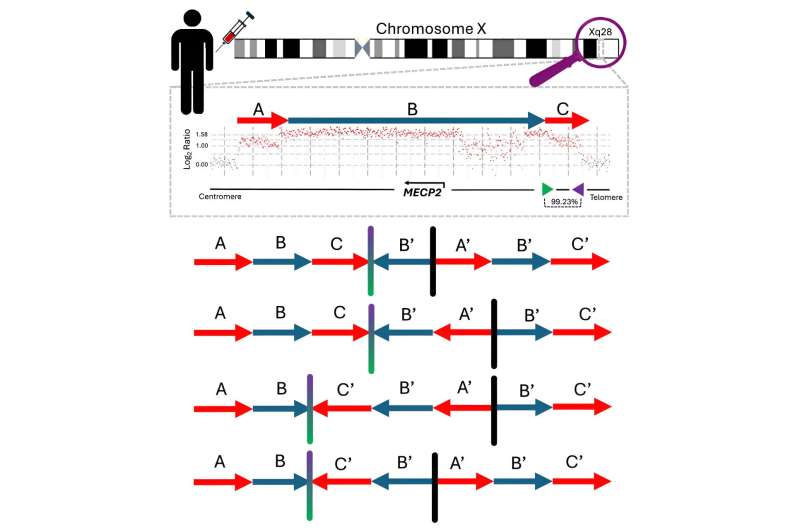This article has been reviewed according to Science X's editorial process and policies. Editors have highlighted the following attributes while ensuring the content's credibility:
fact-checked
peer-reviewed publication
proofread
Study uncovers hidden DNA mechanisms of rare genetic diseases

Researchers at the Pacific Northwest Research Institute (PNRI) and collaborating institutions have made a discovery that could significantly advance our understanding of genomic disorders. Their latest study, published in the journal Cell Genomics, reveals how specific DNA rearrangements called inverted triplications contribute to the development of various genetic diseases.
Genomic disorders occur when there are changes or mutations in DNA that disrupt normal biological functions. These can lead to a range of health issues, including developmental delays and neurological problems. One type of complex DNA mutation involves a structure known as a duplication-triplication/inversion-duplication (DUP-TRP/INV-DUP). This study delves into how these complex rearrangements form and their impact on human health.
The research team, led by PNRI Assistant Investigator Cláudia Carvalho, Ph.D., collaborated with her lab colleagues, study lead author Christopher Grochowski, Ph.D., from the James R. Lupski Lab at Baylor College of Medicine, and other scientists to analyze the DNA of 24 individuals with inverted triplications.
They discovered that these rearrangements are caused by segments of DNA switching templates during the repair process. Normally, DNA repair mechanisms use the undamaged complementary strand as a template to accurately repair the damaged DNA. However, sometimes during repair, the repair machinery may inadvertently switch to a different but similar sequence elsewhere in the genome.
These switches occur within pairs of inverted repeats—sections of DNA that are mirror images of each other. Inverted repeats can confuse the repair machinery, leading to the use of the wrong template, which can disrupt normal gene function and contribute to genetic disorders.
- Structural diversity: The study found that these inverted triplications generate a surprising variety of structural variations in the genome, which can lead to different health outcomes.
- Gene dosage impact: These rearrangements can alter the number of copies of certain genes, known as gene dosage. The correct number of gene copies is crucial for normal human development and function. Changes in gene dosage can cause diseases like MECP2 duplication syndrome, a rare neurodevelopmental disorder.
- Mapping breakpoints: By using advanced DNA sequencing techniques, the researchers identified the precise locations where these DNA segments switch templates leading to an altered number of genes including MECP2.
Dr. Carvalho and Baylor scientists first observed this pathogenic genomic structure in 2011 while studying MECP2duplication syndrome. Only recently, with the advent of long-read sequencing technology, has it become possible to investigate in detail how it forms in the genome.
"This study sheds light on the intricate mechanisms driving genetic rearrangements and their profound impact on rare diseases," said Dr. Carvalho, PNRI's lead scientist on the study. "By unraveling these complex DNA structures, we open new avenues for understanding the genetic causes of rare diseases and developing targeted treatments to improve patient outcomes."
These findings are being applied in a follow-up study led by Baylor's Davut Pehlivan, M.D., investigating how complex genomic structures influence the clinical features of MECP2 duplication syndrome and their impact on targeted therapeutic approaches.
More information: Christopher M. Grochowski et al, Inverted triplications formed by iterative template switches generate structural variant diversity at genomic disorder loci, Cell Genomics (2024). DOI: 10.1016/j.xgen.2024.100590



















